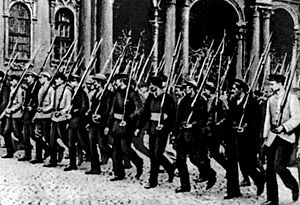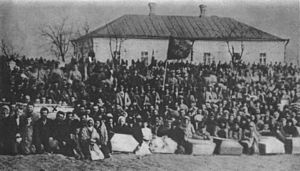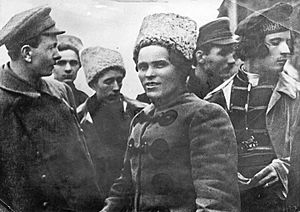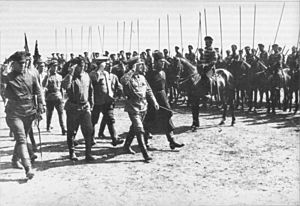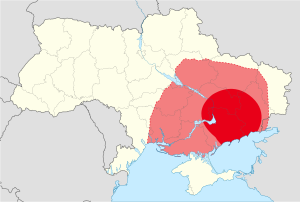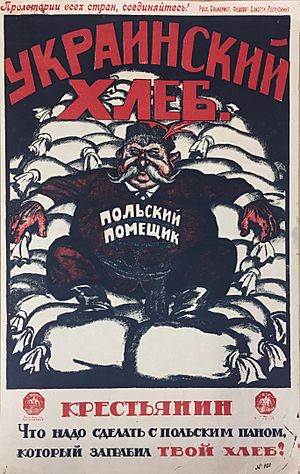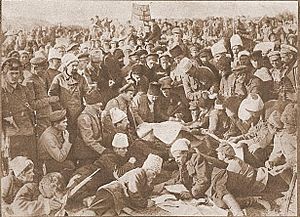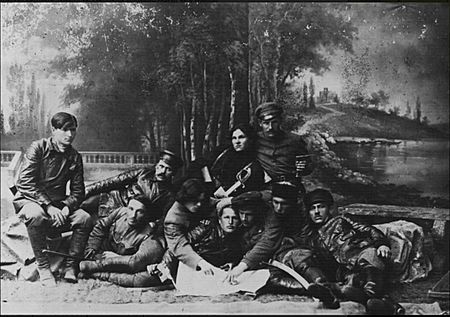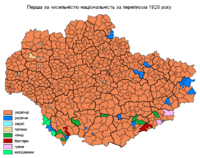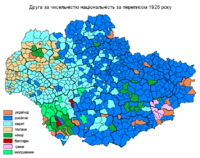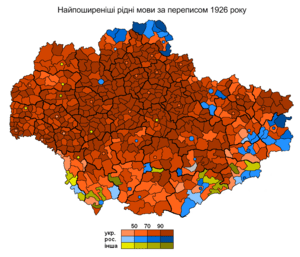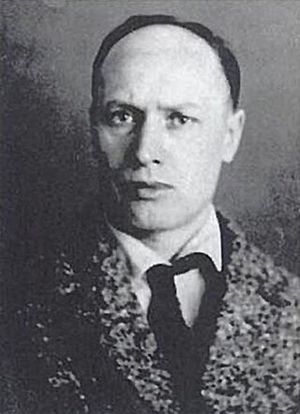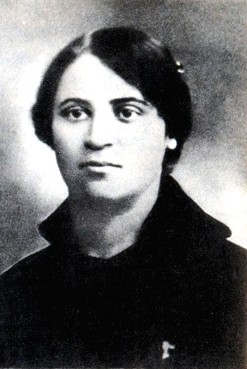Makhnovshchina facts for kids
The Makhnovshchina (pronounced Makh-nov-shchee-nah) was a big movement in southern and eastern Ukraine between 1917 and 1921. It happened during the Ukrainian War of Independence. This movement aimed to create a society where people were truly free and equal, without a government or social classes. It was named after Nestor Makhno, who was the main leader of the Revolutionary Insurgent Army of Ukraine. The goal was to set up a system of "free soviets," which were like local councils where people made decisions together. This was meant to lead to a society without a state or social classes.
The Makhnovist movement started after the February Revolution in Russia. They set up farming communities in Makhno's hometown of Huliaipole. At first, they worked with the Bolsheviks during the Ukrainian–Soviet War. But then, the Central Powers (like Germany and Austria-Hungary) invaded Ukraine. The Makhnovists had to go underground and fought a guerrilla war against them in 1918. After winning the Battle of Dibrivka, the Makhnovshchina took control of a large part of the Katerynoslav region. They started building their own type of free society. They held a Regional Congress of Peasants, Workers and Insurgents to organize the region. A Military Revolutionary Council was also set up to manage things.
In June 1919, the Makhnovists were fighting the White movement in the Donbas. They were surrounded by enemies and eventually lost ground. They had to retreat to Kherson. There, they reorganized their army and launched a successful counterattack against the Whites at the Battle of Peregonovka. After defeating the White advance, the Makhnovists controlled most of southern and eastern Ukraine in late 1919. Even though they were mostly a peasant movement, they even took over some big industrial cities.
However, the Red Army invaded Ukraine in January 1920, which ended the Makhnovist control. This started the Bolshevik–Makhnovist conflict. The Makhnovists fought a guerrilla war against the Red Army, who were enforcing harsh rules like the Red Terror and war communism. The local peasants strongly supported the Makhnovists. For a short time, the Makhnovists and Bolsheviks made a peace deal, the Starobilsk agreement, to fight the remaining White forces. But the Red Army soon attacked the Makhnovists again. They were finally defeated by August 1921. Many Makhnovist leaders either went into exile, were defeated, or were captured and killed by the Red Army.
Contents
What was the Makhnovshchina?
The word "Makhnovshchina" can be thought of as the "Makhno movement." It refers to a large movement of people who wanted a social revolution. They supported the anarchist leader Nestor Makhno and his Revolutionary Insurgent Army of Ukraine (RIAU).
The area controlled by Makhno's army was also called "Makhnovia." People sometimes called it a "liberated zone" or "autonomous area" because it was free from government control.
How did the Makhnovshchina begin?
Early Days in Ukraine
The area where the Makhnovshchina started was around Zaporizhzhia. This land used to belong to the Cossacks before the Russian Empire took it over. It became the Katerynoslav province and was mostly used for farming. This led to a few wealthy landowners and a middle class of farmers called kulaks. Many poor peasants tried to resist changes that threatened their traditional farming communities. By the 1900s, the region was a major grain producer, exporting almost half its wheat.
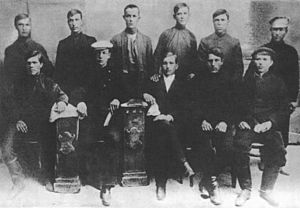
Land prices went up, making it hard for poor peasants to buy land. This made them angry at the rich landowners and kulaks. With help from their local governments, peasants started their own farming groups. They traded their grain in a system that mixed market ideas with socialist ones. This helped develop farming industries in Katerynoslav, which made a lot of farm machinery for the Russian Empire. This also brought together farmers and factory workers. People moved to industrial towns for work and then back to their villages during tough times. The region became very diverse, with Ukrainians, Russians, Germans, Jews, and Greeks living together. Russian became the common language.
Because of this mix of people, Jewish communities in the region faced less antisemitism compared to other parts of Ukraine. Young Jewish people helped start the Ukrainian anarchist movement. This movement became important during the 1905 Revolution in Ukraine. In Huliaipole, there were strikes and robberies by a group of young anarchists called the Union of Poor Peasants. Their leaders were eventually caught and many were sentenced to death or life in prison.
Revolution and Early Actions (1917-1918)
After the February Revolution in 1917, Ukrainian thinkers formed the Central Council of Ukraine. They wanted things like freedom of the press and education in the Ukrainian language. Eventually, they declared Ukraine's independence. At the same time, the Ukrainian anarchist movement grew stronger, especially when Nestor Makhno returned from prison.
Makhno became a key figure. The anarchists in Huliaipole formed a peasants' union. They took control of the town from the government and set up a local council, or Soviet. This was the start of their plan for a free society. Huliaipole was moving very quickly towards these ideas. They had a big May Day celebration and supported workers' uprisings. The Makhnovist movement took land from the rich landowners and gave it to the peasants. They wanted to end the idea of a few people owning all the land. By summer 1917, peasants stopped paying rent and put land under a shared trust.
In August 1917, a decision was made that put Katerynoslav within Russia, which the anarchists rejected. The Russian Minister of Agriculture tried to change land laws, but the government stopped him. However, the government lost control of Katerynoslav, and the Makhnovists became very powerful. They decided to change land ownership themselves. On October 8, the Huliaipole Congress of Soviets announced that all land owned by the rich would be taken and shared by everyone. Many landowners fled. Attempts to bring the region back under government control failed because of armed anarchist groups and workers' strikes.
On November 7, 1917, Ukraine declared its independence. Katerynoslav was now part of Ukraine. But in eastern Ukraine, Soviet influence grew, and a Ukrainian Soviet Republic was formed in Kharkiv. A civil war soon broke out between the two Ukrainian groups.
Before the October Revolution, the Makhnovists had already set up "soviet power" in Katerynoslav. They gave workers control over factories. When the Bolsheviks took power with the slogan "all power to the soviets," Ukrainian anarchists supported them at first. But they were critical of too much central control. The Makhnovists wanted Soviet power in their region, so they fought against the new Ukrainian state. An anarchist group helped capture Oleksandrivsk and set up Soviet power there. By January 1918, southern Ukraine was mostly under Soviet control. In Huliaipole, the local revolutionary committee included anarchists and other socialist groups.
The Soviet Republic quickly took over territory, capturing the Ukrainian capital of Kyiv on February 8, 1918.
Fighting for Independence (1918)
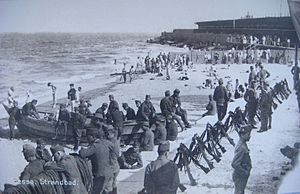
The day after Kyiv fell, Ukraine signed a peace treaty with the Central Powers (Germany and Austria-Hungary). This invited the German army to invade Ukraine and remove the Soviets. The Red Guards couldn't stop them. Within a month, the Bolsheviks also had to sign a peace treaty, giving control of Ukraine to Germany and Austria-Hungary.
In Huliaipole, Ukrainian nationalists threatened anarchists. Anarchists fought back, even killing one nationalist leader. The nationalists then planned a takeover, threatening Jewish communities to get support. On April 15-16, the nationalists attacked the anarchist fighters, disarming and arresting them. The next day, a protest helped free the anarchists, but they couldn't defend the town. The Austro-Hungarian Army soon occupied it. By the end of April, the Ukrainian People's Republic was replaced by the Ukrainian State. This new government gave land back to the rich and took grain from peasants. This made people very angry and started the Ukrainian War of Independence.
Anarchist fighters met in Taganrog and decided to return to Huliaipole in July 1918 to fight the occupation. When they came back, Ukraine was already in revolt. Hundreds of thousands of people were fighting and striking, even with harsh punishments. Peasant groups, led by various commanders, attacked the occupation forces. Some joined other groups, but the largest followed either socialist revolutionary Nykyfor Hryhoriv or Makhno.
On September 30, Makhno and Fedir Shchus's groups joined up and defeated the occupation forces. When World War I ended in November, the occupation forces started leaving. In western Ukraine, the Ukrainian State was overthrown, and the Ukrainian People's Republic was reestablished. In the Pryazovia region, the Makhnovshchina quickly took control. On November 27, Huliaipole, the Makhnovshchina's capital, was taken back by the fighters. They restarted the local council and trade unions. Soon, the Makhnovshchina's territory grew, reaching as far west as Katerynoslav and as far south as the Sea of Azov.
Building a Free Society (1918-1919)
With the occupation over, the Makhnovshchina focused on building a free society. They held a Regional Congress of Peasants, Workers and Insurgents. This Congress was the highest authority. It declared its goal to create "a society without ruling landowners, without subordinate slaves, without rich or poor." It urged workers and peasants to build this society themselves, without harsh rules.
Under the Military Revolutionary Council (VRS), which was chosen by the people, the Makhnovshchina started a new education system. They gave out land and set up farming cooperatives. A Soviet commander reported that the Makhnovists had many schools, hospitals, and "children's communes." Huliaipole became a very cultured place. The VRS also started adult education and gave people many civil liberties, like freedom of speech, press, and assembly. They even let the Bolsheviks spread their ideas. During this time, peasants believed that "land belongs to no one, and only those who work it may use it." The largest farming commune was named after Rosa Luxemburg. In May 1919, it had 285 members and 125 hectares of land.
Anarchist thinkers like Peter Arshinov and Aron Baron came to Huliaipole. Anarchist newspapers like The Road to Freedom spread their ideas. These new thinkers helped the Makhnovshchina develop its anarchist ideas. They wanted to rebuild Ukrainian society with "free soviets." These soviets were independent of political parties. Workers started setting them up, some even getting money from the Makhnovists to make up for lost wages. The goal was to have an "all-Ukrainian labor congress" that would become the new central government for an independent Ukraine, run by the workers themselves.
Around this time, the Bolsheviks broke their peace treaty and ordered the Red Army to invade Ukraine. They set up the Ukrainian Soviet Socialist Republic in Kharkiv. The Makhnovshchina was surrounded by different enemies, so they allied with the Bolsheviks to keep "soviet power" in the region. They made it clear it was only a military alliance, not a political one. As part of the Red Army, the Makhnovists captured and expanded their territory.
However, the Bolsheviks soon started to use harsh methods. They favored factory workers over peasants. On April 13, the Soviet government started taking food from peasants to feed the cities. They shot any peasants who resisted, which caused many peasant revolts. The Cheka (Soviet secret police) also carried out the Red Terror, with reports of arbitrary arrests and economic hardship. Red Army soldiers even robbed people and carried out antisemitic pogroms (attacks on Jewish communities). In contrast, the Makhnovshchina was much more peaceful. They had diverse members and severely punished antisemitism.
The Bolsheviks' central control and authoritarian style clashed with the Makhnovshchina's ideas of local democracy and freedom. In May 1919, tensions grew when Nykyfor Hryhoriv led an anti-Bolshevik uprising. His army carried out antisemitic attacks. The Makhnovists decided to fight Hryhoriv and stay allied with the Bolsheviks, hoping to get official freedom for their territory. But tensions only increased, and the Makhnovists eventually broke away from their Bolshevik commanders.
Retreat and Counterattack (1919)
When the Military Revolutionary Council called a special meeting, the Bolshevik government saw it as an act of treason. They ordered the meeting to be stopped and its participants to be shot. The Bolsheviks then attacked the Makhnovshchina, killing some of their leaders and forcing the fighters to flee. This started a period of guerrilla warfare. By June 1919, the Makhnovshchina's freedom was crushed by both the Red Terror and the White Terror.
At this time, the White movement broke through Soviet lines in the Donbas. The Kuban Cossacks captured Huliaipole from the Makhnovists. Since the Red Army had also declared war on the Makhnovshchina, the local fighters had no Bolshevik support. Many peasants had to defend the town themselves with farm tools and a few rifles. The Cossacks killed many peasant rebels and gave land back to the former owners, causing many peasants to leave the town.
The Makhnovists fled to western Ukraine and joined up with Nykyfor Hryhoriv's army. But after finding out Hryhoriv had carried out antisemitic attacks, the Makhnovists killed him. They then rebuilt their forces to fight the Whites. By September 1919, the Makhnovshchina was pushed back to Uman, the last stronghold of the Ukrainian People's Republic. To care for their wounded, the Makhnovists made a temporary alliance with the Ukrainian government. Then, they turned back and attacked the White forces. After the Battle of Peregonovka, the Whites were defeated. The Makhnovists pushed them back into Katerynoslav, which came back under Makhnovist control on November 11, 1919.
Peak of Control (1919-1920)
The Makhnovist advance brought a second period of rebuilding. They again set up a system where workers controlled businesses. Wherever the fighters captured a city, locals were invited to choose their own union representatives and councils (Soviets). These groups would then hold a regional meeting to make decisions for the area.
Workers' meetings were held in Oleksandrivsk from October 27 to November 2. They brought together 180 peasant representatives, 20 worker representatives, and 100 delegates from political groups and army units. Volin, who led the meeting, suggested they create "free soviets" that were not controlled by any political party. Eleven delegates from other parties disagreed and left the meeting. A Bolshevik delegate also disagreed, rejecting the idea of anarchy.
By December 1919, an outbreak of epidemic typhus weakened the Makhnovist forces. This allowed the White movement to briefly recapture Katerynoslav and the Red Army to invade the region.
Red Terror and Retreat (1920-1921)
By the end of January 1920, the Red Army had taken over the Makhnovshchina's territory. The Cheka (secret police) disarmed the local people. They took villagers hostage while searching homes, killing hostages if they found any hidden weapons. One report mentioned a massacre in the Makhnovist town of Novospasivka, where the Cheka "shot down one in every two able-bodied men." Some historians describe this period as a "genocide," with an estimated 200,000 Ukrainian peasants killed during the Red Terror.
The Bolshevik government also forced a system called war communism in Ukraine. They took food and livestock from peasants and even stopped them from fishing or hunting. They said this was to fight against rich peasants, even though by then, very few peasants owned large amounts of land. State-owned farms also failed. This led to many peasant revolts. Before late 1920, over 1,000 Bolshevik food collectors were killed by Ukrainian peasants.
The Makhnovists fought a guerrilla war against the Bolsheviks. They attacked small Red Army groups and destroyed infrastructure. In areas they captured, they ended war communism and gave back the seized food to the peasants.
Temporary Peace (1920)
After a successful attack by the White Army, the Makhnovists and Bolsheviks formed an alliance again. Their agreement, called the Starobilsk agreement, stated that:
- All anarchist political prisoners would be freed.
- The Bolsheviks would stop persecuting anarchists.
- Anarchists would have civil liberties like freedom of speech, freedom of the press, and freedom of association, as long as they didn't speak against the Soviet government.
- Anarchists could freely participate in elections to the local councils (Soviets).
A fourth point would have given the Makhnovshchina complete freedom to set up their own self-governing system in southeastern Ukraine. But the Bolsheviks disagreed, fearing it would limit their access to railways and attract all their opponents. This issue was put off.
With Ukrainian anarchists free to operate again, they quickly pushed the White Army out of Huliaipole. Makhnovist control was reestablished. They started a plan to reorganize the economy and society based on anarchist ideas. By mid-November, "free soviets" were being rebuilt, and new schools and theater shows were happening daily. One observer noted that the region still showed scars of war, with trenches and destroyed houses. Even children played war games based on recent events.
Final Defeat (1920-1921)
After helping the Bolsheviks defeat the White Army in Crimea, the Bolsheviks turned against the Makhnovshchina on November 26, 1920. Many important Ukrainian anarchists were arrested and shot. The Makhnovist capital of Huliaipole was captured by the Red Army. The Cheka increased the Red Terror in Ukraine, ordering soldiers to disarm peasants and shoot anyone who resisted. They also arrested and executed suspected Makhnovists. In place of the free soviets, the Bolsheviks set up committees of poor peasants to run the villages.
To escape punishment, the Makhnovist army retreated. They traveled through many regions before returning to Katerynoslav in February 1921. They hoped to spread their movement to new areas. However, the Bolshevik government's new economic policy made many Ukrainian peasants less willing to fight. This led to military defeats and fewer Makhnovist fighters. On August 28, 1921, Nestor Makhno and his forces fled to Romania. Ukraine then came completely under the control of the Ukrainian Soviet Socialist Republic.
How the Makhnovshchina was Organized
The Makhnovshchina's political system was called a "people's commune" or an "anarchist republic." It was based on the idea of anarcho-communism. It used a network of trade unions, factory committees, peasant committees, and local meetings. These meetings were like referendums where decisions were made directly by the people. Most decisions were made independently at the village and district levels. Networks of "free soviets" were places where people discussed and solved problems together.
Local Self-Government
The "free soviets" were the main way the Makhnovshchina was organized. These councils acted independently, without a central government. They did not allow political parties to participate. They met to manage the activities of workers and peasants through direct participation. The soviets were local self-governing bodies and connected with each other up to the regional and national levels. This made the organization very flat, with little hierarchy. However, the war made it hard to set up this system widely, as people were mostly focused on finding food and staying safe.
Regional Congress and Leaders
The Regional Congress of Peasants, Workers and Insurgents was the "highest form of democratic authority" in the Makhnovshchina. It brought together representatives from peasants, factory workers, and soldiers. They discussed issues and took decisions back to their local meetings. Four Congresses were held in 1919. One was banned by the Bolsheviks, and another couldn't happen due to fighting.
The Military Revolutionary Council (VRS) acted as the main executive body between Congress meetings. It handled both military and civilian matters. However, the Congress could remove its members at any time, and its actions were limited to what the Congress allowed. At each Congress, the VRS had to report its activities and could be reorganized. For decisions made by local councils and meetings, the VRS only gave advice and had no power over them.
Army and Freedom
The Revolutionary Insurgent Army of Ukraine (RIAU), led by Bat'ko Nestor Makhno, was the main armed force. It was mostly made up of peasant fighters and supported by the peasants. The RIAU captured large parts of southern Ukraine. Its goal was to "serve and protect" the social revolution in Ukraine, but it promised not to force its ideas on the people. The civilian VRS oversaw the army, and Makhno himself was mostly a military strategist. Some historians believe that neither the army command nor Makhno truly controlled the movement; they simply reflected the wishes of the people.
Civil liberties were first introduced in southern and eastern Ukraine after the February Revolution. But they were stopped when the war began, as different groups controlled the territory. After the White movement was defeated in October 1919, and the Makhnovshchina expanded, freedom of speech, freedom of the press, and freedom of association were all brought back.
Because of freedom of the press, many newspapers appeared. These included official papers from different political groups like the Socialist Revolutionary Party, Left Socialist-Revolutionaries, Bolsheviks, Mensheviks, and anarchist groups. The Insurgent Army also had its own newspaper, Road to Freedom.
How the Makhnovshchina Worked Economically
Workers and peasants in Ukraine saw the October Revolution's promise of "Factories to the Workers; Land to the Peasants!" as a chance for them to control industries and get land. In Makhnovist areas, they used a system that mixed market ideas with socialist ones. This especially helped peasants and workers who made goods. They also had social welfare programs that shared wealth.
Farming Communities
In the first year of the Russian Revolution, Ukrainian peasants took land from rich landowners and farmers. They gave it to those who worked it, creating a farming economy based on socialist ideas. After a political event called the Kornilov affair, the Huliaipole defense committee took weapons and property from the wealthy. All private businesses came under workers' control. Peasants took over the farms they worked, and large estates were turned into shared farming communities. These communities were settled by landless families and individuals, with about 200 members each.
The first commune, named after Rosa Luxemburg, was very successful. Even though few members were anarchists, they ran the communes based on full social equality, including gender equality. They followed the idea of "from each according to their ability, to each according to their need." Land was shared, and meals were eaten in shared kitchens. However, members could cook separately if they wished. Work was managed by the workers themselves. Work plans were agreed upon voluntarily at general meetings. If someone couldn't work, their neighbors would find a replacement. Many commune members felt that communal life was the "highest form of social justice." Some former landowners even chose to live this new way.
One commune, called "Tocsin," had 100 families on an estate with wheat fields and orchards. The local council divided and supplied the estate. Many former factory workers joined this commune because it promised "well-being for everybody." Others joined because they believed in the ideas. Some peasants made fun of the city communists who joined, but this teasing was not mean, as the peasants still helped the unskilled workers. However, this commune eventually broke up as workers left one by one.
Industry and Money
While the Makhnovshchina was mostly a farming society, they also tried to organize industries in the cities they briefly controlled. Most of the fighters were peasants and didn't fully understand large industries. When they took over cities, they held workers' meetings to restart production under workers' control. When city workers asked for their wages, which hadn't been paid since the White occupation, the Makhnovists suggested they get payment directly from their customers.
Railroad workers in Oleksandrivsk started organizing a self-managed economy in 1919. They formed a committee to organize the railway network, planning train movements and passenger transport. Councils were soon formed to coordinate factories across Ukraine.
In Katerynoslav, local anarchists worked to bring the city's industries under social ownership. Workers won agreements at a tobacco factory, and the city's bakeries came under workers' control. Anarchist bakers made plans to ensure enough food for everyone.
Many industrial workers became unhappy with the Makhnovshchina and supported other political groups. At one Regional Congress, delegates from another party were called "counter-revolutionaries" for speaking against the Makhnovist idea of free soviets, and they left the meeting.
The Makhnovshchina faced problems with money. Peasants could live without money by farming for themselves, but city workers needed money to buy food. When direct exchange of goods wasn't possible, the Makhnovshchina mostly continued to use money. They planned to create a moneyless system after the war.
At first, trading goods directly was popular. The Huliaipole Soviet traded grain for cloth with factories in Moscow. But the new Soviet government demanded that this independent trading stop and be controlled by the government.
Even though anarchists preferred trading goods directly, they knew poor workers still needed money. So, they allowed the use of any currency, including old Russian rubles and Ukrainian money. One story even says the Makhnovists printed their own money, which stated that "no-one would be prosecuted for forging it."
The regional congresses collected money from wealthy people and banks, taking millions of rubles. They then started a large wealth redistribution program. Poor people could apply for help from the Military Revolutionary Council. One person in Katerynoslav reported that thousands of people lined up daily for these packages, receiving different amounts based on their needs. This redistribution continued until the last days of Makhnovist control.
The Makhnovists' lack of experience with money led to high inflation. The changing war situation also caused currency values to change wildly. They also didn't control prices, which caused the price of bread to rise by 25% during their control.
People and Culture
The Makhnovshchina's territory was mainly in the regions of Pryazovia and Zaporizhzhia. At its largest, it had about 7.5 million people living across 75,000 square kilometers. It covered five provinces, including all of Katerynoslav.
Different Groups and Languages
After World War I, old empires were breaking apart, and many new countries were forming based on national groups. But the Makhnovshchina's territory was very multicultural and resisted the growing idea of Ukrainian nationalism. Most people (90%) were Ukrainians, but there were also 6-8% Russians, and the rest were Greek and Jewish communities. There were also smaller groups of Armenians, Bulgarians, Georgians, Germans, and Serbs.
The Makhnovshchina wanted to break down the idea of state-based nations. They aimed to build local relationships based on anarchist principles. In February 1919, the Second Regional Congress declared against nationalism. It called on "workers and peasants of every land and all nationalities" to join a social revolution to overthrow the state and capitalism. In October 1919, the Military Revolutionary Council hoped to end the "domination of one nationality over others" by using free soviets. While they supported the right of Ukrainians and other nations to choose their own path, they saw nationalism as "bourgeois and negative." They called for a "union of nationalities" under socialism, believing it would help each culture grow.
The Makhnovists strongly opposed antisemitism, which they saw as a leftover from the old Russian Empire. The Military Revolutionary Council even declared a "war on anti-Semitism." Attacks on Jewish people were much less common in Makhnovist territory than in other parts of Ukraine. Any cases of antisemitism were severely punished. After one attack on Jewish people in Makhnovist territory, the fighters responsible were executed, and weapons were given to local Jewish communities for their protection. Many important Makhnovist figures were Jewish.
However, anti-German feelings were allowed among the Makhnovists due to old tensions between Ukrainian peasants and German colonists. After a battle where German collaborators helped the Austro-Hungarian Army, the Makhnovist army attacked German communities. Violence against Germans increased when some German groups allied with the White movement. After a major battle, when the Makhnovists quickly took over southern and eastern Ukraine, hundreds of Germans were killed in massacres.
The different governments during the war changed language policies in Ukraine. The Ukrainian State promoted the Ukrainian language. When the White Army took over, they banned Ukrainian in schools and enforced Russian. After the Makhnovists defeated the White movement, their "Cultural Enlightenment Section" declared that people should be educated in whatever language the local population used, chosen by the people themselves. In most villages, this meant a return to Ukrainian and an end to Russian being the main language.
However, Russian was still widely used in eastern Ukraine. Since the 1905 Revolution, Ukrainian anarchist writings were mostly in Russian. This continued when Russian anarchists came to the Makhnovshchina. But a small group of Ukrainian thinkers, led by Halyna Kuzmenko, pushed for more use of the Ukrainian language in propaganda and education. This led to the Makhnovist movement becoming more Ukrainian. In late 1919, they started publishing a Ukrainian version of The Road to Freedom and a new paper called Anarchist Rebel. But this was the limit of their Ukrainian publications, as they lacked editors and printing presses for Ukrainian.
Education and Arts
During the 1917 Revolution, anarchists in Huliaipole first suggested a new education system, inspired by a Spanish teacher named Francesc Ferrer. One member, Abram Budanov, started a Cultural-Educational section for the Makhnovist movement. This section published pamphlets, held meetings, and organized schools, theater shows, and music events. When the war started, the Military Revolutionary Council oversaw this section. In early 1919, Russian anarchist thinkers came to southern Ukraine and worked for this section. Peter Arshinov, who had taught Nestor Makhno in prison, became its chairman and edited the newspaper The Road to Freedom. Later, other anarchists joined him. They believed that cultural and educational institutions should be free from state control and run by voluntary groups.
The Makhnovshchina's education system was led by Halyna Kuzmenko, a Ukrainian teacher. As early as the February Revolution, teachers were setting up schools in Huliaipole. By 1919, three high schools were established despite the war. Adult education, focusing on political ideas, was also done by educators within the army. But by the time of the peace with the Bolsheviks in October 1920, most teachers had fled, and few schools were open. Following the ideas of the Ferrer movement, the Makhnovshchina planned to open new workers' schools, supported by local communities, for both children and adults. One anarchist suggested building an anarchist university in Kharkiv, but Nestor Makhno disagreed. He felt schools were most needed in rural areas and that building a university in a big city showed too much central control.
Meanwhile, the cultural section traveled with the army, publishing flyers and newspapers using a mobile printing press. When the army stopped, the cultural section provided entertainment and organized meetings where they promoted free soviets. As part of their cultural activities, Makhnovist men and women put on daily amateur theater shows. They acted out recent history and stories of the army. The theater section had different groups for musical, dramatic, opera, and satirical shows. The Cultural-Educational Section often used entertainment to raise money for wounded fighters, holding plays and auctions. Music was also important, with musical groups often playing at meetings. The harmonica was popular among the fighters. Makhnovist musicians played original songs, including their own version of a folk song that showed fighters winning against the White movement.
After a major battle and renewed Bolshevik attacks, the Makhnovist cultural and educational programs were destroyed. Bolshevik reforms to education included removing the final year of high school and requiring all teachers to be elected. Political leaders were placed in all schools to remove teachers who disagreed with the party.
Cities in the Makhnovshchina
While the Makhnovshchina was mostly rural, it also included some large cities. The army captured several after the Battle of Peregonovka. Its capital was Nestor Makhno's relatively small hometown of Huliaipole, which the Bolsheviks nicknamed "Makhnograd."
|
Largest cities or towns in the Makhnovshchina
Encyclopedia of Ukraine |
||
|---|---|---|
| Rank | Pop. | |
| 1 | Katerynoslav | 189,000 (1920) |
| 2 | Yelisavetgrad | 65,000 (1926) |
| 3 | Oleksandrivsk | 58,517 (1917) |
| 4 | Mariupol | 30,000 (1921) |
| 5 | Berdiansk | 26,400 (1926) |
| 6 | Huliaipole | 25,000 (1917) |
| 7 | Melitopol | 22,022 (1912) |
| 8 | Nikopol | 21,282 (1897) |
| 9 | Kryvyi Rih | 19,000 (1923) |
| 10 | Polohy | 16,490 (1959) |
Images for kids
See also
 In Spanish: Majnóvschina para niños
In Spanish: Majnóvschina para niños
- Armed Forces of South Russia
- Revolutionary Catalonia
- Korean People's Association in Manchuria


